
Headline writing has always been an elusive art and the nature of the web and social media in particular – in that the headline is not necessarily contextualised by surrounding stories or images, as in print – has changed the game. Choose around ten words from over a million to accurately, succinctly and attractively portray a story. Go.
Here are some guidelines for headline writing – both on the web and in print – but if you have more tips and pointers to share then feel free to do so in the comments.
1. Remember the basics
Grammar can take a bit of a back seat in headlines; the aim here is to quickly convey the key information in the article while giving the reader a reason to read on.
With that in mind, auxiliary verbs and articles can often be cut out and many words can be replaced with punctuation – a comma instead of 'and', a colon instead of 'said' – to make the headline tighter or more active.
Also: single quote marks for quotes in a headline and only capitalise the first word or after a colon. Here at Journalism.co.uk (and elsewhere) we write numbers as figures, not words. Numbers are important, as we will discuss later, but a figure is quicker to read than a word in a headline.
This guide from Allan Metcalf of the Chronicle of higher Education covers the bases. And always make 100 per cent sure the spelling is correct.
2. Be concise
This should be a given considering what we are trying to achieve, but it can be difficult to get across a complex idea in a few, key words. Tough. That's the job.
@journalismnews keep it tight, fit for a quick reader scan, cut out - is, has, etc. but read through, check it still makes sense! #weblines
— Richard Kendall (@richardkendall) February 12, 2014
The BBC is often credited with having consistently tight headlines, as Jakob Nielsen, co-founder of the user-experience research company the Nielsen Norman Group, explains in this blog post.
Nielsen puts the BBC's experience in radio and Ceefax as the main cause for their journalists' consistently accurate brevity. Headlines across the news section of the website average out at six words each, seeing through the finer details of a story to deliver its core to the reader.
Nielsen recommends visiting "the site daily for a week and try to apply some of the BBC editors' discipline to your own headlines".
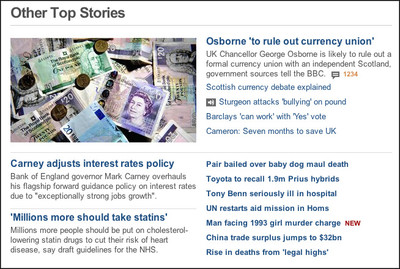
Screenshot from BBC News
There is a little more leeway online than the stringent, physical restrictions of print headlines, but it always helps to keep things short. This online thesaurus offers up shorter synonyms for headlines, should the need arise.
3. Verbs
Copywriters everywhere will recognise the mantra to "let the verbs do the work"; a good verb can transform the meaning of a sentence and bring it to life. This can be particularly true for sports stories but are equally applicable to any field where a bit of descriptive variation can elevate a headline.
Sorry Arsenal fans, but the following are increasingly vivid examples of a headline after a recent English Premier League match:
"Liverpool beat Arsenal"
"Liverpool demolish Arsenal"
"Liverpool dominate Arsenal"
"Liverpool destroy Arsenal"
"Liverpool crush Arsenal"
"Liverpool humiliate Arsenal"
The choice of verb will depend on the editorial voice, but the idea remains the same, backed up by self-proclaimed "social media scientist" Dan Zarella, who investigated the science of Twitter.
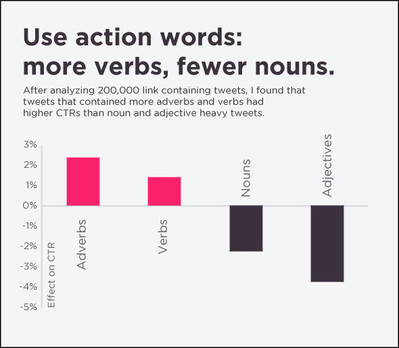
Screenshot from DanZarella.com
Some recent studies have looked at the most read, shared and clicked on headlines and found not only that the statistics lean heavily towards verbs over nouns in a headline, but 'darker' words may be more effective as well.
"‘Google shuts down Google Reader’? Or ‘Google kills Google Reader’?" wrote Iris Shoor, co-founder and vice president of tech firm Takipi, after analysing headines through a specifically designed software script. "The second version is much more likely to get more shares."
Other words that apparently drew a lot of interaction were 'fear', 'dark', 'bleeding' and 'war', and while taking such a darker tone in a headline will not always be relevant to a story, a more negative angle can be more effective when it comes to shares, she said.
"'Why Facebook is not a social company' or 'Why Facebook is an enterprise company?'," continued Shoor. "Go with the first one. The words 'no', 'without' and 'stop' lead to many more shares."
And in the age of social media dominance, shares are just as important as clicks. So...
4. Social media optimisation
Finding effective patterns or strategies in social media is the subject of entire conferences but the basic aim is to make it noticeable and shareable.
The first factor should be the physical length of a tweet, leaving enough space for comments, retweets or shares. Around 100 characters should be a maximum in that respect, although Zarella's research suggests that slightly longer tweets may be better in terms of click-through rate, with links placed earlier.
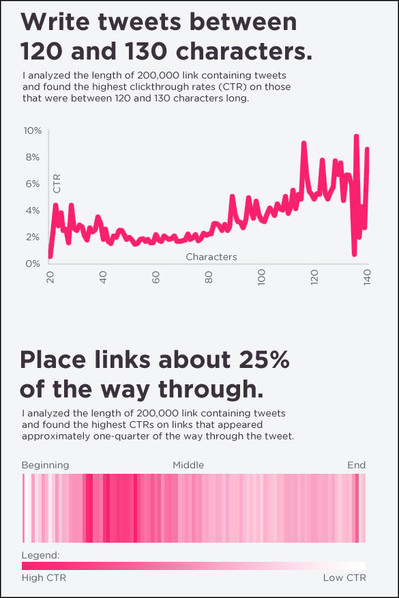
Screenshot from DanZarella.com
On Facebook and other social media sites with more flexibility for length the issue becomes more complex, however.
Content marketing consultant Barry Feldman put together a neat mnemonic acronym for what he believes is important for effective headline writing:
Helpful
Emotion
Ask
Dos and Donts
List
Inspire
Nightmare
Empathy
Success
He goes into more detail on each area in his blog but the key points are to make the reader feel something and give them a reason to both read and share the story.
5. People like numbers and lists
"Whenever we encounter new information, our brains immediately try to make sense of it," wrote Maria Konnikova in The New Yorker last year, giving one of a number of reasons "why our brains love lists".
The phenomenon of 'listicles' may be infuriating to some, but when done well it helps the reader to quickly order and understand new information. Headlines work in a similar way.
6. Make it surprising
The basic human traits of surprise and curiosity rule our behaviour in more ways than we are aware of and despite the wonders of modern technology we are still essentially monkeys looking for the next banana.
In a 2001 study, scientists squirted either fruit juice or water into the mouths of willing participants in a predictable or unpredictable pattern, finding that the surprise factor lit up more "pleasure centres" in the brain than the participants preference for juice.
Backing up that science with more science, or at least stats, Shoor found that the word "surprising" featured in some of the most viral posts crawled by her software.
The creation of a "curiosity gap" has been a consistent feature of posts from sites like Upworthy, specialising in making articles shareable and viral on social media.
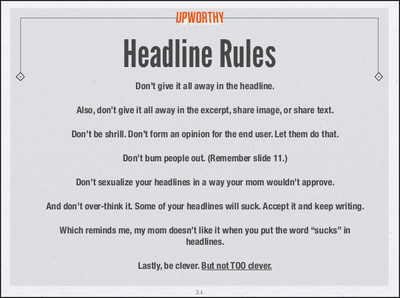
Screenshot from Upworthy's slideshare presentation on viral articles
News organisations should refrain from over gilding the lily, such as ending headlines with "YOU'LL NEVER GUESS WHAT HAPPENED NEXT", when the reader could easily do so. This sort of 'build up' should probably be avoided altogether for serious news reports, but the 'curiosity gap' theory is a useful idea to bear in mind for lighter content.
Pique the reader's interest and give them a (real) reason to read on.
7. Search engine optimisation (SEO)
Headlines in print have a visual context, either in their placement near other relevant stories or by a picture. Search engines have no idea about context, so you need to spell it out for them, making the keywords glaringly obvious.
Susan Steade, online news producer for San Francisco's Bay Area News Group, likes to go by the "mullet model" of headline writing for SEO: "business up front, party in the back".
"[It] can be broken down to three best practices," she told Steve Buttry, digital transformation editor at Digital First Media, for a post on his blog in November. "Know what people are searching for, get those search terms up front, play up the hot angle."
This guide from Trinity Mirror's Malcolm Coles goes into detail on what people search for and how to get picked up by Google, and the video below gives some key insight into the topic.
Tip of the hat to @computerklaus for this video
Steade's final point, to "play up the hot angle", is specific to each publication so it is important to...
8. Tailor it to your audience
When a large story breaks, all major news organisations will report on it and follow up with comment pieces and op-eds specifically suited to what their audience like and expect. The same should apply for every story – the tone, angle and content should all be targeted at your readers.
The cherry on top of your deliciously-moulded, audience-specific story cake is the headline, not just for SEO, but for social media and general browsing. Know what tickles your audience's tastebuds and give them what they want, how they want it.
9. Test, test, test
At Upworthy, the editorial strategy dictates that a writer must come up with 25 headlines for every article.
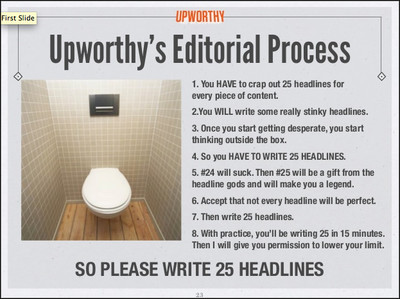
Screenshot from Upworthy's slideshare presentation on viral articles
Not everyone has the time or desire to write so many but a process of trial and error should be built in to finding out what kind of headlines work for your audience.
That may mean writing a number of different headlines for one story and seeing which gets the most reaction online. Tweeting a story at the same time on different days with different headlines may give you an idea of what elements work better in the headline and what people respond to.
At Buffer, Leo Widrich has put together a "scientific" guide to headline writing on the web with tests for Twitter, Facebook and blog posts, but without a cure-all solution it is a matter of seeing what works best for you.
If you have any other tips on headline writing for the web feel free to leave them in the comments below.
Free daily newsletter
If you like our news and feature articles, you can sign up to receive our free daily (Mon-Fri) email newsletter (mobile friendly).
Related articles
- What AI can do for your newsroom: tips from Ring Publishing's latest handbook
- 10 creative ways to interview celebrities and experts
- 200 speakers you need at your next journalism event to avoid all-male panels
- How young leaders can shape the future of the media industry
- Tools, tactics, and success stories of newsroom innovation in 2023









